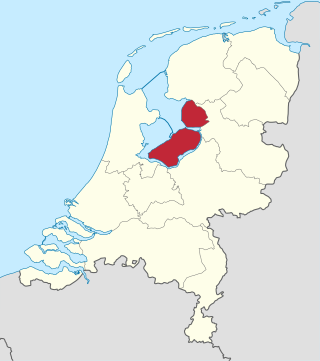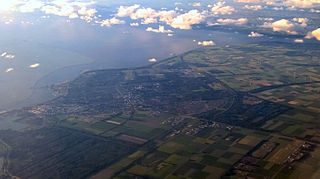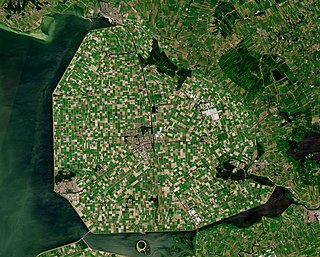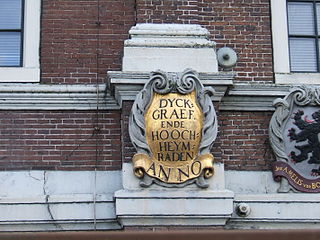
Flevoland is the twelfth and newest province of the Netherlands, established in 1986, when the southern and eastern Flevopolders, together with the Noordoostpolder, were merged into one provincial entity. It is in the centre of the country in the former Zuiderzee, which was turned into the freshwater IJsselmeer by the closure of the Afsluitdijk in 1932. Almost all of the land belonging to Flevoland was reclaimed in the 1950s and 1960s while splitting the Markermeer and Bordering lakes from the IJsselmeer. As to dry land, it is the smallest province of the Netherlands at 1,410 km2 (540 sq mi), but not gross land as that includes much of the waters of the fresh water lakes (meres) mentioned.

A polder is a low-lying tract of land that forms an artificial hydrological entity, enclosed by embankments known as dikes. The three types of polder are:
- Land reclaimed from a body of water, such as a lake or the seabed
- Flood plains separated from the sea or river by a dike
- Marshes separated from the surrounding water by a dike and subsequently drained; these are also known as koogs, especially in Germany

Lelystad is a Dutch municipality and the capital city of the province of Flevoland in the central Netherlands. The city, built on reclaimed land, was founded in 1967 and was named after Cornelis Lely, who engineered the Afsluitdijk that made the reclamation possible. Lelystad is situated approximately three metres below sea level.

The IJssel is a Dutch distributary of the river Rhine that flows northward and ultimately discharges into the IJsselmeer, a North Sea natural harbour. It more immediately flows into the east-south channel around the Flevopolder, Flevoland which is kept at 3 metres below sea level. This body of water is then pumped up into the IJsselmeer.

The Zuiderzee Works is a system of dams and dikes, land reclamation and water drainage work, which was the largest hydraulic engineering project undertaken by the Netherlands during the twentieth century. The project involved the damming of the Zuiderzee, a large, shallow inlet of the North Sea, and the reclamation of land in the newly enclosed water using polders. Its main purposes are to improve flood protection and create additional land for agriculture.

Noordoostpolder is a polder and municipality in the Flevoland province in the central Netherlands. Formerly, it was also called Urker Land. Emmeloord is the administrative center, located in the heart of the Noordoostpolder.

Cornelis Lely was a Dutch politician of the Liberal Union and civil engineer. He oversaw the passage of an act of parliament authorising construction of the Zuiderzee Works, a huge project – designed to his own plans – that turned the Zuiderzee into a lake and made possible the conversion of a vast area of former seabed into dry land. Lelystad, the capital of the province of Flevoland, is named after him.

The Markerwaard is the name of a proposed, but never built, polder adjoining the IJsselmeer in the central Netherlands. Its construction would have resulted in the near-total reclamation of the Markermeer.
The year 1956 in architecture involved some significant events.

The Lelystad–Zwolle railway, also known as the Hanzelijn, is a Dutch railway line, finished in 2012. It connects Lelystad, capital of the province of Flevoland, with Zwolle, capital of the neighbouring province of Overijssel, and provides a direct rail link between Flevoland and the north-east of the Netherlands.
The Netherlands has several levels of administrative subdivisions. The first level of subdivision consists of 12 provinces. The second level of subdivision consists of 342 municipalities.

The Flevopolder is an island polder forming the bulk of Flevoland, a province of the Netherlands. Created by land reclamation, its northeastern part was drained in 1955 and the remainder—the southwest—in 1968.

In the Netherlands, a water board, water council or water authority is a regional governing body solely charged with the management of surface water in the environment. Water boards are independent of administrative governing bodies like provinces and municipalities. In general, they are responsible for managing rivers and canals, issues with the flow of watercourses and drainage issues, water collection, flood and erosion prevention and provision of potable water. They manage polder systems, water levels, water barriers and locks, enforcements, water quality and sewage treatment in their respective regions. The concept of a coordinating "High Water Authority" (Hoogheemraadschap) originated in what now is the province of South Holland in the 12th century.

The pilot Polder Andijk, or Test Polder Andijk, Proefpolder Andijk in Dutch, is a polder established in 1926 - 1927 in the Zuiderzee near the village of Andijk. The aim of this prototype is to study the embankments and agriculture for future polders in the Zuiderzee Works. In 1929, the pilot polder was inaugurated by Queen Wilhelmina of the Netherlands.

Land reclamation in the Netherlands has a long history. As early as in the 14th century, the first reclaimed land had been settled. Much of the modern land reclamation has been done as a part of the Zuiderzee Works since 1919.

Hermanus Johannes Lovink was a Dutch agriculturist, horticulturist, and politician. The son of a gardener, Lovink took to agriculture and horticulture from a young age, becoming the supervisor of public lands in Zutphen in 1887. Building on this experience, he gained a leadership position with the Association for Wasteland Redevelopment, in which capacity he oversaw several land reclamation projects. After being appointed Director General of Agriculture by Johannes Christiaan de Marez Oyens in 1901, he expanded agricultural education and promoted agricultural expansion; he continued these programs in the Dutch East Indies after being made Director of the Department of Agriculture, Industry, and Trade by Alexander Idenburg in 1909.

The H. J. Lovink Pumping Station is a pumping station in Biddinghuizen, a village in the municipality of Dronten, Flevoland, the Netherlands. Named for Hermanus Johannes Lovink, an agriculturist who was extensively involved in land reclamation, the station was designed by Dirk Roosenburg and completed in 1956. It was used for the reclamation of the eastern Flevopolder in 1957 and contributed to the reclamation of the island's southern areas. The station was designated a rijksmonument on 13 December 2010.

Jacob Martijn Roosenburg, better known as Teun Roosenburg, was a Dutch sculptor. The son of the architect Dirk Roosenburg, he attended the Royal Academy of Art in the Hague and the Académie Ranson in Paris. He worked with several materials, depicting various subjects in a figurative style. He and his wife Jopie occupied the Oost Castle from 1941, from which they led an art colony.

Oost Castle is a manor house in Oost-Maarland, a village in Eijsden, Limburg, the Netherlands. Located along the Meuse, it can be traced to an 11th-century motte-and-bailey residential tower that was expanded several times between 1548 and 1800. After falling into dilapidation, it was renovated in 1848 but had fallen into dilapidation again by the beginning of World War II.

Hendrik Wortman was a Dutch civil engineer. Born in Amersfoort, Utrecht, he graduated from Delft Polytechnic in 1880 and joined the Rijkswaterstaat. He took offices throughout the country, focusing particularly on questions of water management and hydraulic engineering, until he was seconded to the Ministry of Public Works, Trade, and Industry in 1894. In this capacity, he developed several infrastructure projects, including a harbour in Scheveningen, while preparing exploratory studies for damming of the Zuiderzee.




















